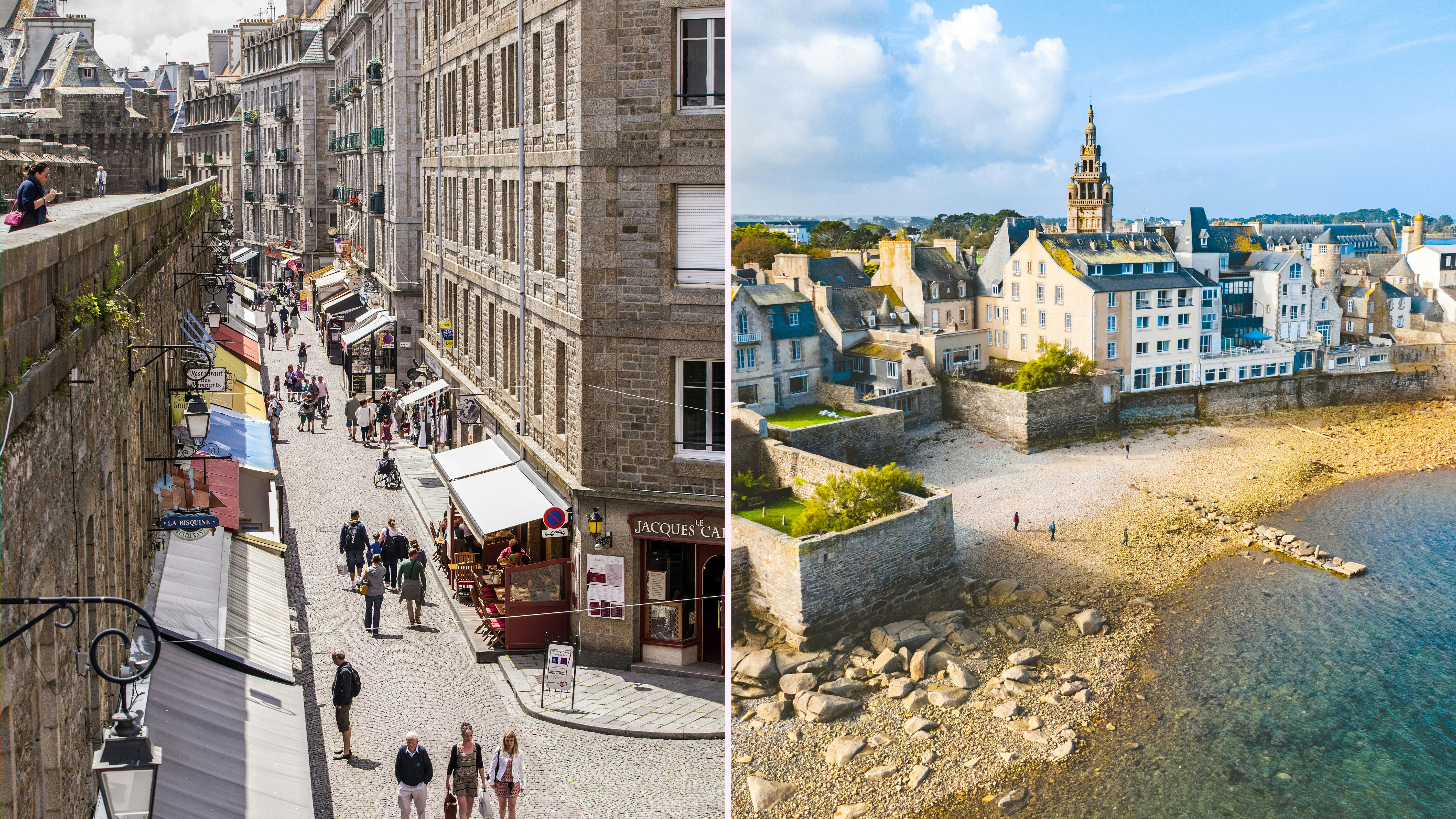
The much visited cliffs of Étretat (left); the same high chalk cliffs can be seen at sleepy Yport, 20 minutes further along the road © Shutterstock
France's most iconic sites often come with a crowd. Here are some alternative places to visit.
The Paris Olympics will put France front and center this summer, bringing major crowds to the French capital, along with other Olympic host cities across France (Lille, Lyon, Saint-Etienne, Nice, Bordeaux, Nantes and Marseille, Teahupo’o in Tahiti).
To escape the tourist crowds this season, here are a few alternative ideas to popular French attractions and destinations among both locals and tourists alike.
Popular attraction: the cliffs of Étretat
Already a prized site among the French for its dramatic white cliffs and rock formations, the seaside town of Étretat in the north of France became an international hot spot after being featured in the hit Netflix series Lupin, starring Omar Sy.
During the summer high season, the village of 1200 residents can see upward of 10,000 visitors descend on the area per day.
The alternative: Yport
Drive east along the same coast for just 20 minutes and you arrive at Yport, a fishing village that boasts the same high chalk cliffs and ocean views – without the maddening crowds. After exploring the charming village, head to the beach for some surfing, canoeing, paddle boarding or sunbathing, or lace up your boots for a hike along the coast.

Popular attraction: Mont St-Michel
One of the most-visited national monuments in France thanks to the fairy-tale Benedictine abbey that rises out of the bay, the UNESCO World Heritage Site marked its milestone 1000th anniversary in 2023.
The alternative: Solesmes Abbey
In the Sarthe Valley in western France, you’ll find another Benedictine abbey that also boasts a 1000-year heritage, also with waterfront views (albeit of a river) and likewise monumental. An active center of Gregorian monastic life, the abbey of Solesmes is home to 40 monks. Visit the grounds by bike, or take in the site via a river cruise along the banks of the Sarthe.

Popular destination: the coves of Marseille
The unique limestone formations and 26 coves draw countless tourists to Calanques National Park, the first national park of its kind in Europe to be at once terrestrial, marine, island and peri-urban (adjoined to an urban metropolis). To preserve the environmental integrity of the area, authorities have imposed visitor limits.
The alternative: the Blue Coast
Named after the color of its waters, the Côte Bleue (Blue Coast) stretches northwest of Marseille and also features coves, small ports and beaches, all popular among the locals. Hike the Douaniers trail, rent a private boat to explore the coves by water, shop the markets of Sausset-les-Pins or Martigues, or seek out some waves at popular surfing spots.

Popular attraction: Château de Versailles
The stunning, gilded royal residence outside Paris and its grounds are a living symbol of the French court’s power and influence over Europe during its heyday – and accordingly attract about seven million visitors a year. The palace also reopened Marie-Antoinette’s private chambers to the public in 2023.
The alternative: Château de Chantilly
About the same time and distance from Paris as Versailles, the Château de Chantilly is a reasonable alternative if you’re a lover of fine art and gardens. This castle boasts the second-largest collection of old-master paintings after the Louvre, and its sprawling gardens were designed by the same gardener as Versailles, André Le Nôtre.
The charming collection of small houses that make up the Hameau (hamlet) in the domain’s Anglo-Chinese garden also served as the model for Marie-Antoinette’s Hameau in the Petit Trianon in Versailles.

Popular attraction: Giverny
Impressionist painter Claude Monet lived and worked out of his family home in Giverny for 43 years, carefully preserving and maintaining the gardens and water lilies which inspired some of his most famous works. Expect major crowds in peak spring and summer season.
The alternative: Auvers-sur-Oise
Like Giverny, Auvers-sur-Oise is less than an hour’s train ride outside Paris, and is also famous for being home to one of art history’s most famous painters: Vincent Van Gogh. The Post-Impressionist painter spent the last two months of his life in this small, tranquil town, which he described as “seriously beautiful” in a letter to his brother Theo. During his short time there, he was incredibly prolific and completed 80 paintings. Follow in the artist’s footsteps and visit the church that inspired his painting The Church at Auvers (which is on display at the Musée d’Orsay), and the Auberge Ravoux, where his bedroom has remained untouched since the painter’s death in 1890.
Looking for more day trips from Paris? Here's our pick of the best

Popular destination: St-Malo
This historic maritime city in Brittany is famous for its tall granite walls built in the 12th century to protect the old town, and its charming medieval streets and alleyways. The town got a tourism boost after serving as the key setting in Anthony Doerr’s Pulitzer Prize-winning 2014 novel All the Light We Cannot See, which was released as a mini-series by Netflix in 2023. But disgruntled locals expressed their anger at the town’s overcrowded streets last year, hanging signs that read: “Stop overtourism. St-Malo is not Disney Malo”.
The alternative: Roscoff
Also in Brittany, and likewise a port city, Roscoff shares many of the characteristics that make St-Malo so popular: a historic old town, the charm of a picturesque fishing village, granite architecture, boutiques and galleries. But Roscoff is also popular among the French for its seaside resorts specializing in thalassotherapy, sea and saltwater spa treatments with a history that dates back to the late 19th century. A short ferry ride away is also the Île de Batz, which features coastal trails and the Georges Delaselle Garden, home to 2500 plant and flower species.

Popular attraction: the Eiffel Tower
No introduction needed here, the Iron Lady is the most visited paid monument in the world, attracting 7 million visitors every year — and with it, long wait times and crowds.
The alternative: Montparnasse Tower
As the only skyscraper, and the tallest building in Paris, the rooftop of the Montparnasse Tower offers the best bird’s eye view of the city. The attraction also boasts Europe’s fastest elevator, whisking visitors to the 56th floor observation deck in 38 seconds. On a clear day, visitors can see up to 25 miles (40km) in every direction, including the silhouette of the Eiffel Tower. The rooftop terrace also offers an open-air experience. One of the newer attractions is a VR experience that recreates Paris through the ages. The rooftop of the Galeries Lafayette department store in the 9th arrondissement is another alternative, but the vantage point is significantly less panoramic.
Wondering when to visit Paris? Here's our seasonal guide

Popular attraction: Biarritz
A ritzy resort town in southwest France, Biarritz is popular among affluent tourists, wave-seeking surfers and golfers.
The alternative: Guéthary
For a quieter version of Biarritz, head just a little further south along the coast and spend the day at Guéthary, a small Basque fishing village that was once famous for whale hunting. The town has three beaches, and boasts some of the best, most challenging surf spots in the region, including Parlementia and Avalanche. After watching surfers from the Terrasse promontory which overlooks the ocean, follow the coastal path for a waterfront hike, before settling in for an alfresco meal at one of the many outdoor restaurants with views of the sea.

Popular attraction: Disneyland Paris
Year in and year out, Disneyland Paris regularly tops the list of most-visited attractions in France, making for long wait times at rides and increasing the probability of meltdowns — child and adult alike.
Le Jardin d’Acclimatation, Paris
Admittedly, there are no Mickey or Minnie sightings at Paris’s only amusement park. But if the goal is simply to keep the kids happy and entertained for a day, the Jardin d’Acclimatation, located in the west end of the city in the Bois de Boulogne, ticks many boxes. Inaugurated in 1860 as part of Napoleon III’s ambitious restructuring plan for Paris, the park reopened in 2018 after a big refurbishment project carried out by its latest owner LVMH. The park spans 18 hectares and features 42 attractions, including mini roller coasters, a chair swing ride, VR experiences and children’s workshops.






